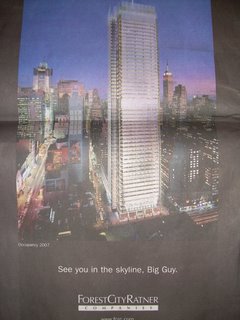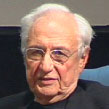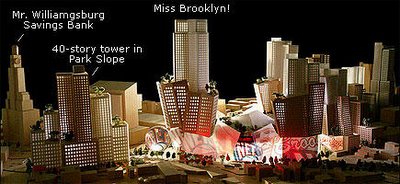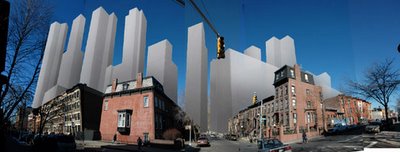 Deyan Sudjic, the architecture critic for London's Observer newspaper, last year published The Edifice Complex: How the Rich and Powerful Shape the World. As the subtitle indicates, this is not an appreciation of decontextualized aesthetics but a world-historical tour of architecture in the service of leaders, democratic and demagogic, and the wealthy. If read through a Brooklyn-centric lens, it prompts some reflections about Bruce Ratner, Frank Gehry, and the Atlantic Yards project.
Deyan Sudjic, the architecture critic for London's Observer newspaper, last year published The Edifice Complex: How the Rich and Powerful Shape the World. As the subtitle indicates, this is not an appreciation of decontextualized aesthetics but a world-historical tour of architecture in the service of leaders, democratic and demagogic, and the wealthy. If read through a Brooklyn-centric lens, it prompts some reflections about Bruce Ratner, Frank Gehry, and the Atlantic Yards project.Telling the story of those who build it
Taking off from a picture of Saddam Hussein at the Mother of All Battles Mosque, Sudjic observes:
Architecture is about power. The powerful build because that is what the powerful do. On the most basic level, building creates jobs that are useful to keep a restless workforce quiet. But it also reflects well on the capability and decisiveness--and the determination--of the powerful. Above all, architecture is the means to tell a story about those who build it.
 It seems that Forest City Ratner has discovered the role of architecture. FCR first build a series of projects involving designs that were ordinary or, like MetroTech, were derided. Then, in building the Times Tower with a high-profile media partner, the developer had to ramp up. An architect was chosen in a competition, and now FCR heralds Renzo Piano's building in full-page newspaper ads.
It seems that Forest City Ratner has discovered the role of architecture. FCR first build a series of projects involving designs that were ordinary or, like MetroTech, were derided. Then, in building the Times Tower with a high-profile media partner, the developer had to ramp up. An architect was chosen in a competition, and now FCR heralds Renzo Piano's building in full-page newspaper ads.Sudjic comments generally on Piano's work for Fiat patriarch Gianni Agnelli:
It's not hard to see that Piano's genuine fascination with elegan mechanisms and high-performance materials represents a passion that would have aroused a sympathetic resposne in a tycoon who was equally passionate about speed in the form of fast boats and even faster cars. But however the buildings look, and whatever they are made of, as it has turned out, Piano has all along been designing structures that are in fact the embodiment of the most traditional of all architectural impulses. They speak of power, continuity, and memory.
The Atlantic Yards story
After the Times Tower--FCR's first foray into high-end architecture--came the even more ambitious (and controversial) Atlantic Yards project, and the hiring of Frank Gehry. So, capitalizing on the Times Tower and Atlantic Yards, Bruce Ratner can be seen not merely as a savvy developer who can maximize shareholder value. Ratner in the past has participated in cultural entities like the board of the Brooklyn Academy of Music, but now he has finally stepped up to create culturally notable buildings.
 As Kurt Andersen wrote, in an 11/28/05 New York magazine article headlined Delirious New York, there was a political reason for involving Gehry (right, photo from Columbia University web site):
As Kurt Andersen wrote, in an 11/28/05 New York magazine article headlined Delirious New York, there was a political reason for involving Gehry (right, photo from Columbia University web site):Ratner isn’t spending 15 percent extra on these new buildings simply because he wants to underwrite cool design. He understands that in Brooklyn, just as his quotas of apartments for poor people and construction jobs for women and minorities were ways of winning over key constituencies, hiring Gehry was politics by other means, sure to please the city’s BAM-loving chattering class. “The spirit of what you say,” Ratner agrees when I posit this theory, “is accurate.”
The limits of criticism
Part of what allows architects to succeed among the "chattering class" is a focus on aesthetics over politics. Sudjic also observes:
We are used to discussing architecture in terms of its relationship to art history, or as a reflection of technological change, or as an expression of social anthropology. We know how to categorize buildings by the shapes of their windows or the decorative detail of their column capitals. We understand them as the products of available materials and skills. What we are not so comfortable with is coming to grips with the wider political dimensions of buildings: why they exist, rather than how.
 Indeed, in Chapter 14 of my report, I pointed out how New York Times critics Herbert Muschamp and Nicolai Ouroussoff (right) barely looked at Forest City Ratner's track record. They didn't plumb Ratner's reasons for engaging Gehry. Nor did they fully engage the question of scale, and how the oversize nature of the project might not be merely an expression of "cultural flowering" (in Ouroussoff's phrase), but also an attempt to build big enough to ensure a certain level of profit.
Indeed, in Chapter 14 of my report, I pointed out how New York Times critics Herbert Muschamp and Nicolai Ouroussoff (right) barely looked at Forest City Ratner's track record. They didn't plumb Ratner's reasons for engaging Gehry. Nor did they fully engage the question of scale, and how the oversize nature of the project might not be merely an expression of "cultural flowering" (in Ouroussoff's phrase), but also an attempt to build big enough to ensure a certain level of profit.An "elusive sense of settled ease"
It's interesting that Gehry is trying to transform 19th-century Brooklyn, since Sudjic observes that the architect's important source of inspiration is modern Los Angeles (along with childhood memories):
With its seemingly random urban landscape of colliding shapes and odd juxtapositions, Gehry's architecture reflects the context in which it was born. When you are surrounded by freeways, giant advertising signs, and drive-in restaurants in the shape of giant bowler hats or hot dogs, there is not much point trying to create chaste, well-mannered buildings.
Now, interestingly enough, Gehry's working on a new L.A. downtown.
While Sudjic writes critically of many projects and buildings, he lauds Scotland's new Parliament building in Edinburgh, designed by Enric Miralles and Benedetta Tagliabue:
Walk around the foot of the Royal Mile, past the gates of Holyroodhouse Palace, and up toward Salisbury Crags, the volcanic cliff that looms over Edinburgh's Georgian terraces. It's a site of quite exceptional beauty and there, unwinding in front of you, is Miralles's parliament. It suggests an elusive sense of settled ease. It belongs to its surroundings.
 Well, that's a high bar for any project, and some buildings, like Gehry's Guggenheim in Bilbao, have been lauded not for "settled ease" but for their modernist flash. Sudjic writes of the Bilbao museum (right):
Well, that's a high bar for any project, and some buildings, like Gehry's Guggenheim in Bilbao, have been lauded not for "settled ease" but for their modernist flash. Sudjic writes of the Bilbao museum (right):His design was a sensation because it looking nothing like an art gallery--or, for that matter, not much like a piece of architecture, at least not as architecture had previously been understood. With its puckered titanium-skined roof, swooping and soaring through the bridges and embankments that line Bilbao's river, the Guggenheim was more like a train crash than a building, a homemade mutant version of the Sydney Opera House.
..Gehry had also succeeded in unleashing a wave of exhibitionistic architecture, motivated as much by materialistic as by cultural concerns.
 It's hard to imagine that the Atlantic Yards project--planned at a major discontinuity from the surrounding scale--could achieve "settled ease." But "exhibitionist architecture"--at least in terms of the arena block--is more likely the goal. (Graphic of earlier version of plan from 7/5/05 New York Times, with addenda by NoLandGrab.org.)
It's hard to imagine that the Atlantic Yards project--planned at a major discontinuity from the surrounding scale--could achieve "settled ease." But "exhibitionist architecture"--at least in terms of the arena block--is more likely the goal. (Graphic of earlier version of plan from 7/5/05 New York Times, with addenda by NoLandGrab.org.)The politics and the fray
Sudjic notes that architects must engage the powerful:
Le Corbusier and Mies van der Rohe, Rem Koolhaas and Renzo Piano, Wallace Harrison and Frank Gehry, are not free agents. Their work depends on their engagement with the political context of the world.
 And, at the same time, a distance from the fray. Could we expect Gehry to comment that the Atlantic Yards project overrides city zoning? (Graphic from OnNYTurf.) Or that the achievement of affordable housing is partly dependent on an out-of-scale project? Or that it was achieved via a sweetheart deal, given that the MTA was negotiating with Ratner for 18 months before the Vanderbilt Yard was put out to bid?
And, at the same time, a distance from the fray. Could we expect Gehry to comment that the Atlantic Yards project overrides city zoning? (Graphic from OnNYTurf.) Or that the achievement of affordable housing is partly dependent on an out-of-scale project? Or that it was achieved via a sweetheart deal, given that the MTA was negotiating with Ratner for 18 months before the Vanderbilt Yard was put out to bid?Rather, we hear Gehry declaring himself to be a "do-gooder," just like his patron. However, their personal political proclivities, in the voting booth and in charitable endeavors, do not make this process transparent and democratic--or honest.
Regarding the advantages and disadvantages of a celebrity like Gehry, architect Jonathan Cohn observes:
While he is more likely to be successful in influencing the developer-provided project direction, he may also be less likely to listen to the ideas, input, and concerns of others. An architect with major commissions around the world may not have the time or interest to learn much about the unique site conditions of each one.
Indeed, can Gehry do Brooklyn and Los Angeles--and his host of other projects--justice at the same time?
The bottom line
 Gehry's buildings can be stunning and his work admirable, but the Atlantic Yards project (arena block at right from AtlanticYards.com) shouldn't be analyzed separately from the larger context. It's disappointing that the architecture critics in New York have barely touched on the issue. Then again, they're often more concerned with art. Sudjic writes:
Gehry's buildings can be stunning and his work admirable, but the Atlantic Yards project (arena block at right from AtlanticYards.com) shouldn't be analyzed separately from the larger context. It's disappointing that the architecture critics in New York have barely touched on the issue. Then again, they're often more concerned with art. Sudjic writes:Architects have given up trying to persuade us that buildings have the power to make our lives better or worse. Of course architecture can do that, in the sense that leaking roofs make us wet and weather-tight ones keep us warm, but that is not what interests most architects. Perhaps that is why architects are now so keen to pose as artists, liberating themselves from the alibi of function.
For Gehry, one might speculate, there are several motivations. To design his first sports arena. To establish himself in New York, a city from which his work has long been absent, until the InterActive headquarters that is nearly finished.
 To "build a neighborhood from scratch in an urban setting," as he told the 12/11/03 New York Times (A Grand Plan in Brooklyn for the Nets' Arena Complex). To work on what he mistakenly called an "empty site."
To "build a neighborhood from scratch in an urban setting," as he told the 12/11/03 New York Times (A Grand Plan in Brooklyn for the Nets' Arena Complex). To work on what he mistakenly called an "empty site." But he's not motivated to design the entire project. Gehry has said that "Normally I would’ve brought in five other architects, but one of the requirements of this client is that I do it." Bruce Ratner, for whatever reasons--deadline pressure, consistency, the Gehry imprimatur on each building for sales purposes--wants Gehry to design the whole project, and Gehry complies.
Why? Perhaps because, as the book says, "the rich and powerful shape the world." Or perhaps, as Ratner (photo from New York Times Magazine, 6/26/05) told the Times Magazine last June, in response to a question about the acquisition of the New Jersey Nets, "Like so many things in life, it was just a matter of money."
Comments
Post a Comment